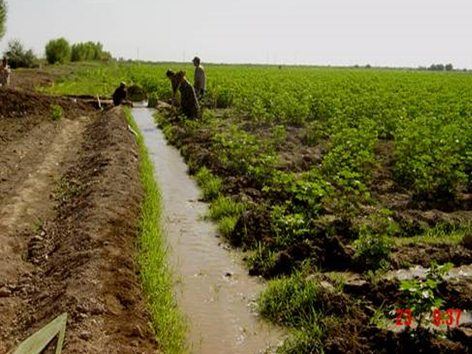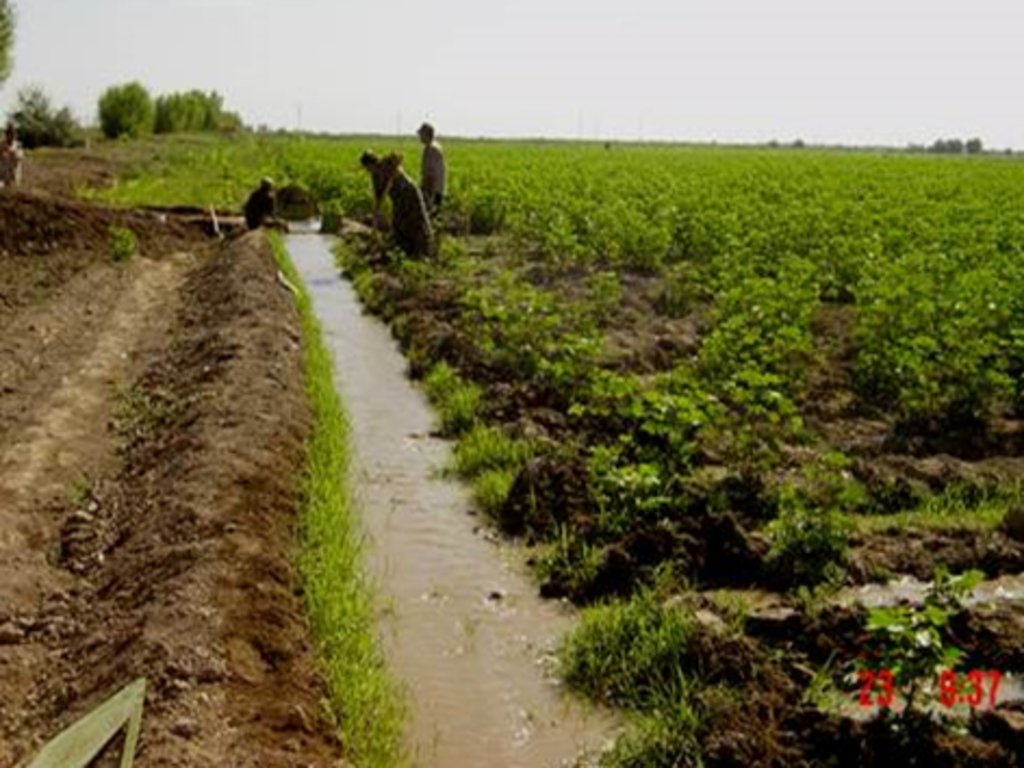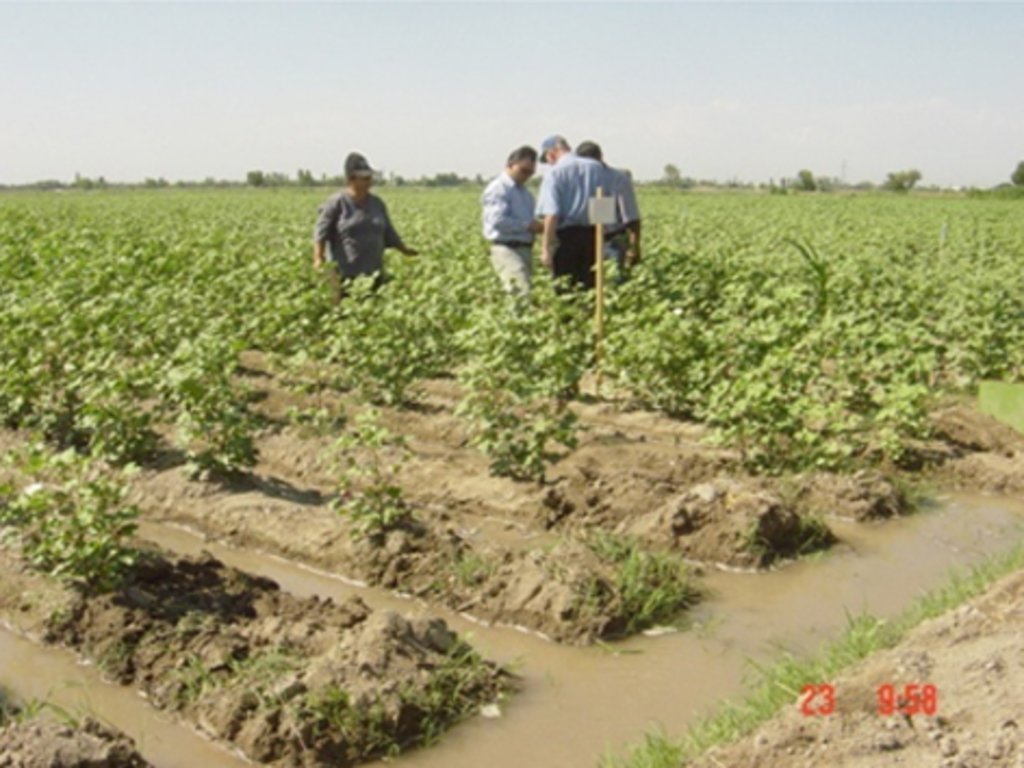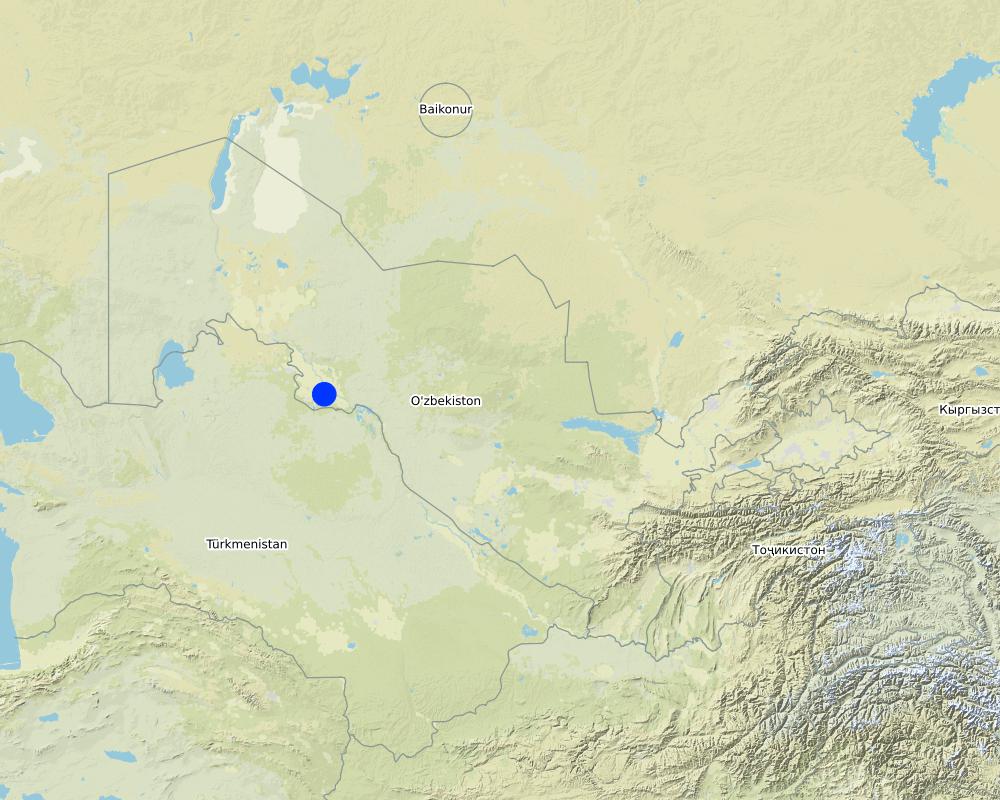Counter watering method of furrow irrigation [Uzbekistan]
- Creation:
- Update:
- Compiler: Rustam Ibragimov
- Editor: –
- Reviewers: Elizaveta Soloveyva, Olga Andreeva, Alexandra Gavilano
Counter watering method of furrow irrigation
technologies_4042 - Uzbekistan
View sections
Expand all Collapse all1. General information
1.2 Contact details of resource persons and institutions involved in the assessment and documentation of the Technology
Key resource person(s)
SLM specialist:
Paluasheva Gauhari, Kalbaevna
SANIIRI Institute (now-Research Institute of irrigation and water problems at Tashkent Institute of irrigation and mechanization of agriculture)
Uzbekistan
SLM specialist:
Shirokova Julia, Illarionovna
SANIIRI Institute (now-Research Institute of irrigation and water problems at Tashkent Institute of irrigation and mechanization of agriculture)
Uzbekistan
land user:
Dzhalilova Totikhon
Khorezm Experimental Farm
Uzbekistan
Name of project which facilitated the documentation/ evaluation of the Technology (if relevant)
Decision Support for Mainstreaming and Scaling out Sustainable Land Management (GEF-FAO / DS-SLM)1.3 Conditions regarding the use of data documented through WOCAT
The compiler and key resource person(s) accept the conditions regarding the use of data documented through WOCAT:
Yes
1.4 Declaration on sustainability of the described Technology
Is the Technology described here problematic with regard to land degradation, so that it cannot be declared a sustainable land management technology?
No
2. Description of the SLM Technology
2.1 Short description of the Technology
Definition of the Technology:
Furrow Irrigation by forced water supply from two sides of the field with the use of single output irrigators - from the beginning and from the end of the furrow or strip (”counter" furrow irrigation) is used for irrigation of cotton and other row crops. The technology is used on low-slope / non-slope lands, which allows to ensure homogenity of moisture, reducing soil salinity in the end part of the field, increasing irrigation water productivity and crop yields
2.2 Detailed description of the Technology
Description:
Furrow surface irrigation method is traditional in Uzbekistan on row crops. It is quite simple and low cost, but low efficient. According to N. Laktaev (1978), V. Sevryugin (2001), even with an optimal combination of irrigation technique elements, the coefficient of uniformity of wetting of the field area does not exceed 0.5-0.4 points. However, on lands subject to salinization, the furrow surface irrigation is preferable, as it provides downward flows of water and regulates soil salinization in the root zone. Therefore, to increase the efficiency of the irrigation water use, it is necessary to improve irrigation along the furrows, which is especially important for flat lands with small slopes. For such conditions, furrow irrigation is recommended, which effectiveness has been proven empirically. It regulates the salt regime during the growing season, uniformly moistens the soil and reduces water losses due to the reduction of irrigation duration and the absence of discharges.
The forced supply of water is carried out from single output irrigators on both sides of the field. For this, a permanent irrigation network is created in the area with small surface slopes. The effectiveness of furrow irrigation of cotton on saline lands was tested in the framework of the ZEF / UNESCO project (2004-2006) in the Khorezm region. Year-round monitoring of the components of the water and salt regime included: measurements of precipitation and evaporation, volumes of water supply for irrigation and leaching, soil moisture in the aeration zone, depth and salinity of groundwater and salinization of the soil. As a result, savings of irrigation water by 321 m3 / ha (2004) and 914 m3 / ha (2005) were revealed. The use of counter-irrigation on the farm fields of the Khorezm region ensured a decrease in irrigation water costs by 15-30%, reducing of the salts seasonal accumulation at the end of the furrows, and an increase of cotton productivity by 30-35% (0.5 t / ha). Technology does not cost much. At the initial stage of implementation, there will be additional costs for high-quality field levelling and the preparation of a permanent irrigation network. The acquiring of water metering equipment (a Chipoletti portable spillway for measuring of the water flow rate in the supply sprinkler and 4 Thompson spillways for measuring flow rate in the furrows) is also necessary. In the future, to maintain the technology every year, only the maintenance of irrigation system elements will be needed.
2.3 Photos of the Technology
2.5 Country/ region/ locations where the Technology has been applied and which are covered by this assessment
Country:
Uzbekistan
Region/ State/ Province:
Chencinski district/Khorezm region
Further specification of location:
Pilot production site
Specify the spread of the Technology:
- evenly spread over an area
If precise area is not known, indicate approximate area covered:
- 0.1-1 km2
Map
×2.6 Date of implementation
Indicate year of implementation:
2006
If precise year is not known, indicate approximate date:
- 10-50 years ago
2.7 Introduction of the Technology
Specify how the Technology was introduced:
- during experiments/ research
Comments (type of project, etc.):
The Technology is implemented through the projects aimed at improving of irrigation water use efficiency.
3. Classification of the SLM Technology
3.1 Main purpose(s) of the Technology
- improve production
- equal humidification of the field and minimization of water losses by reducing the timing of irrigation and the absence of discharges
3.2 Current land use type(s) where the Technology is applied

Cropland
- Annual cropping
Number of growing seasons per year:
- 2
Specify:
Natural and climatic conditions of Uzbekistan allow to get 2 crops per year of short growing season crops (vegetables, potatoes), or when they are cultivated after harvesting winter wheat. Major crops - cotton and wheat produce 1 crop / year.
3.4 Water supply
Water supply for the land on which the Technology is applied:
- full irrigation
3.5 SLM group to which the Technology belongs
- irrigation management (incl. water supply, drainage)
3.6 SLM measures comprising the Technology

agronomic measures
- A7: Others
Comments:
Improvement of the surface method of furrow crop irrigation, which is the main one in Uzbekistan, in order to increase the efficiency of irrigation water use
3.7 Main types of land degradation addressed by the Technology

chemical soil deterioration
- Cs: salinization/ alkalinization

biological degradation
- Bl: loss of soil life
Comments:
The soil chemical properties deteriorate due to the development of secondary salinization processes, which is due to natural factors (arid climate, difficult conditions of groundwater outflow due to the topography) and anthropogenic activities (inadequate irrigation and drainage infrastructure, large losses of irrigation water). Biological degradation is caused by the deterioration of the soil organisms habitat due to soil salinization and low humus content.
3.8 Prevention, reduction, or restoration of land degradation
Specify the goal of the Technology with regard to land degradation:
- reduce land degradation
Comments:
The irrigation technology "counter-watering" helps to reduce the seasonal accumulation of salts at the end of the furrows by half
4. Technical specifications, implementation activities, inputs, and costs
4.1 Technical drawing of the Technology
Author:
Palyashova G.
Date:
2015
4.2 General information regarding the calculation of inputs and costs
Specify how costs and inputs were calculated:
- per Technology area
Indicate size and area unit:
1 ha
Specify currency used for cost calculations:
- USD
If relevant, indicate exchange rate from USD to local currency (e.g. 1 USD = 79.9 Brazilian Real): 1 USD =:
4150.0
Indicate average wage cost of hired labour per day:
about 10 USD
4.3 Establishment activities
| Activity | Timing (season) | |
|---|---|---|
| 1. | Leveling of the site | Autumn |
| 2. | Creation of channels and single-breasted sprinklers | May-June |
| 3. | Irrigation (counter irrigation) | June-August |
Comments:
All activities, except irrigation, are carried out according to traditional technology
4.4 Costs and inputs needed for establishment
| Specify input | Unit | Quantity | Costs per Unit | Total costs per input | % of costs borne by land users | |
|---|---|---|---|---|---|---|
| Labour | Labor costs | people / days | 3.0 | 10.0 | 30.0 | 100.0 |
| Equipment | The costs of machinery (planning, creation of channels) | unit/hour | 1.5 | 170.25 | 255.38 | 100.0 |
| Other | Water accounting facilities (Chipoletti spillway) | unit | 1.0 | 19.3 | 19.3 | |
| Other | Water accounting facilities (Thompson spillway) | unit | 4.0 | 19.3 | 77.2 | |
| Total costs for establishment of the Technology | 381.88 | |||||
| Total costs for establishment of the Technology in USD | 0.09 | |||||
If you are unable to break down the costs in the table above, give an estimation of the total costs of establishing the Technology:
381.8
If land user bore less than 100% of costs, indicate who covered the remaining costs:
paid by the project
Comments:
There are 5 units of water accounting facilities, which include - 1 portable Chipoletti spillway to measure water flow in the channel and 4 portable Thompson spillway to measure flow in the furrow
4.5 Maintenance/ recurrent activities
| Activity | Timing/ frequency | |
|---|---|---|
| 1. | Tillage: plot planning, plowing | Autumn |
| 2. | Correction of single-breasted sprinklers (outlet furrows) | May-June |
Comments:
Periodic activities to maintain the Technology include levelling and correction of single-breasted sprinklers
4.6 Costs and inputs needed for maintenance/ recurrent activities (per year)
| Specify input | Unit | Quantity | Costs per Unit | Total costs per input | % of costs borne by land users | |
|---|---|---|---|---|---|---|
| Labour | Labor costs | people / days | 3.0 | 10.0 | 30.0 | 100.0 |
| Equipment | The costs of machinery (correction of single-breasted sprinklers) | unit/hour | 0.5 | 96.4 | 48.2 | 100.0 |
| Total costs for maintenance of the Technology | 78.2 | |||||
| Total costs for maintenance of the Technology in USD | 0.02 | |||||
If you are unable to break down the costs in the table above, give an estimation of the total costs of maintaining the Technology:
78.2
4.7 Most important factors affecting the costs
Describe the most determinate factors affecting the costs:
The Technology does not require high imputs. The most costs relate to the levelling. This measure is very important to ensure the equability of field area moisture when watering on low slope lands
5. Natural and human environment
5.1 Climate
Annual rainfall
- < 250 mm
- 251-500 mm
- 501-750 mm
- 751-1,000 mm
- 1,001-1,500 mm
- 1,501-2,000 mm
- 2,001-3,000 mm
- 3,001-4,000 mm
- > 4,000 mm
Specifications/ comments on rainfall:
90% of precipitation falls during October-May
Indicate the name of the reference meteorological station considered:
Urgench
Agro-climatic zone
- arid
The duration of the growing season is 160 days
5.2 Topography
Slopes on average:
- flat (0-2%)
- gentle (3-5%)
- moderate (6-10%)
- rolling (11-15%)
- hilly (16-30%)
- steep (31-60%)
- very steep (>60%)
Landforms:
- plateau/plains
- ridges
- mountain slopes
- hill slopes
- footslopes
- valley floors
Altitudinal zone:
- 0-100 m a.s.l.
- 101-500 m a.s.l.
- 501-1,000 m a.s.l.
- 1,001-1,500 m a.s.l.
- 1,501-2,000 m a.s.l.
- 2,001-2,500 m a.s.l.
- 2,501-3,000 m a.s.l.
- 3,001-4,000 m a.s.l.
- > 4,000 m a.s.l.
Indicate if the Technology is specifically applied in:
- not relevant
5.3 Soils
Soil depth on average:
- very shallow (0-20 cm)
- shallow (21-50 cm)
- moderately deep (51-80 cm)
- deep (81-120 cm)
- very deep (> 120 cm)
Soil texture (topsoil):
- medium (loamy, silty)
Topsoil organic matter:
- low (<1%)
If available, attach full soil description or specify the available information, e.g. soil type, soil PH/ acidity, Cation Exchange Capacity, nitrogen, salinity etc.
Meadow soils, humus content in the arable layer is less than 1%. The density of soil (g/cm3) - 1.52, maximum water storage capacity (%by weight) - 20.3-21.9%.
5.4 Water availability and quality
Ground water table:
< 5 m
Availability of surface water:
good
Water quality (untreated):
good drinking water
Is water salinity a problem?
Yes
Specify:
water suitable for irrigation and drinking
Is flooding of the area occurring?
No
Comments and further specifications on water quality and quantity:
Water in surface sources is polluted from drainage runoff discharges from irrigation fields
5.5 Biodiversity
Species diversity:
- medium
Habitat diversity:
- medium
Comments and further specifications on biodiversity:
The vegetation is represented by cultivated plant species in the irrigated area: cotton, wheat, vegetables, melons, perennial plantations, fruit and ornamental trees and shrubs
5.6 Characteristics of land users applying the Technology
Sedentary or nomadic:
- Sedentary
Market orientation of production system:
- mixed (subsistence/ commercial)
Off-farm income:
- > 50% of all income
Relative level of wealth:
- average
Individuals or groups:
- individual/ household
Level of mechanization:
- mechanized/ motorized
Gender:
- women
- men
Age of land users:
- middle-aged
Indicate other relevant characteristics of the land users:
Men are the main land users traditionally
5.7 Average area of land used by land users applying the Technology
- < 0.5 ha
- 0.5-1 ha
- 1-2 ha
- 2-5 ha
- 5-15 ha
- 15-50 ha
- 50-100 ha
- 100-500 ha
- 500-1,000 ha
- 1,000-10,000 ha
- > 10,000 ha
Is this considered small-, medium- or large-scale (referring to local context)?
- medium-scale
Comments:
The average size of farms is 35-75 hectares, dekhkan and household plots - up to 0.35 hectares
5.8 Land ownership, land use rights, and water use rights
Land ownership:
- state
Land use rights:
- leased
- through water users Associations and irrigation systems management
5.9 Access to services and infrastructure
health:
- poor
- moderate
- good
education:
- poor
- moderate
- good
technical assistance:
- poor
- moderate
- good
employment (e.g. off-farm):
- poor
- moderate
- good
markets:
- poor
- moderate
- good
energy:
- poor
- moderate
- good
roads and transport:
- poor
- moderate
- good
drinking water and sanitation:
- poor
- moderate
- good
financial services:
- poor
- moderate
- good
6. Impacts and concluding statements
6.1 On-site impacts the Technology has shown
Socio-economic impacts
Production
crop production
Water availability and quality
demand for irrigation water
Ecological impacts
Soil
salinity
6.2 Off-site impacts the Technology has shown
Specify assessment of off-site impacts (measurements):
The Technology does not have negative off-site impacts
6.3 Exposure and sensitivity of the Technology to gradual climate change and climate-related extremes/ disasters (as perceived by land users)
Gradual climate change
Gradual climate change
| Season | increase or decrease | How does the Technology cope with it? | |
|---|---|---|---|
| annual temperature | increase | well | |
| annual rainfall | decrease | moderately | |
| seasonal rainfall | spring | decrease | moderately |
| seasonal rainfall | summer | decrease | moderately |
Other climate-related consequences
Other climate-related consequences
| How does the Technology cope with it? | |
|---|---|
| extended growing period | well |
Comments:
The Technology depends directly on the water source availability. The water source content depends on climatic changes (rainfall)
6.4 Cost-benefit analysis
How do the benefits compare with the establishment costs (from land users’ perspective)?
Short-term returns:
slightly positive
Long-term returns:
positive
How do the benefits compare with the maintenance/ recurrent costs (from land users' perspective)?
Short-term returns:
positive
Long-term returns:
positive
Comments:
The costs of the establishment of the technology are small and relate to high-quality levelling; preparation of a permanent irrigation network (channeles and single output irrigators); acquisition of water accounting facilities. To maintain the Technology, a high-quality levelling is necessary and correction of single output irrigators (output furrows) may be required annually. Increasing of land productivity on 20-30%, reducing the cost of irrigation water and reduction in seasonal salt accumulation, especially in the end sites of furrows are the main benefits of the first year of Technology establishment.
6.5 Adoption of the Technology
- 11-50%
Of all those who have adopted the Technology, how many did so spontaneously, i.e. without receiving any material incentives/ payments?
- 11-50%
6.6 Adaptation
Has the Technology been modified recently to adapt to changing conditions?
No
6.7 Strengths/ advantages/ opportunities of the Technology
| Strengths/ advantages/ opportunities in the land user’s view |
|---|
| Does not require high additional costs |
| The land productivity increases |
| Strengths/ advantages/ opportunities in the compiler’s or other key resource person’s view |
|---|
| The Technology is simple and therefore accessible to all land users |
| Reduces water loss during irrigation, reduces the development of secondary salinization |
| Increases the crops yield |
6.8 Weaknesses/ disadvantages/ risks of the Technology and ways of overcoming them
| Weaknesses/ disadvantages/ risks in the land user’s view | How can they be overcome? |
|---|---|
| The use of water accounting facilities | Trainings and consultations on the use of water accounting facilities |
| The need for perfect levelling | The perfect levelling is required |
| Weaknesses/ disadvantages/ risks in the compiler’s or other key resource person’s view | How can they be overcome? |
|---|---|
| The need for perfect levelling | The perfect levelling is required. Laser levelling is recommended. |
| The need for sufficient water flow in the feed channel. The flow rate of the supply channel must be at least 40 l / s. Two single output irrigators should be supplied with at least 20 l / s in each direction. | Increasing water availability |
7. References and links
7.1 Methods/ sources of information
- interviews with SLM specialists/ experts
5 persons
- compilation from reports and other existing documentation
When were the data compiled (in the field)?
2018
7.2 References to available publications
Title, author, year, ISBN:
Paluashova G. K., Sharafutdinova N. sh., Shirokova Yu. I. Improvement of water-salt regime management of irrigated soil field by means of improvement of surface irrigation technique and monitoring of soil salinization by Express method.
Available from where? Costs?
Scientific reports of the 5th all-Russian conference of young scientists and specialists "New technologies and environmental safety in the shoal" (Kolomna, may 28-30, 2008)
Title, author, year, ISBN:
Talipova sh., Kurbanbaev E. K., Paluashova G., Shirokova Yu. I. Processes of salinization of lands and methods of maintenance of a salt regime of soils in the conditions of close ground waters and low-slope lands of lower reaches of the Amudarya river.
Available from where? Costs?
Materials of the International scientific-practical conference on the 100th anniversary of N. A. Kenesarin "Current state of groundwater: problems and their solutions". Tashkent 2008
Title, author, year, ISBN:
Paluashova G., Shirokova, Y. I. Efficiency of the oncoming cotton irrigation by furrows in the conditions of Khorezm
Available from where? Costs?
Materials of the Republican scientific and practical conference, to the 85th anniversary of SANIIRI. Tashkent 10-11 November 2010
Title, author, year, ISBN:
Paluashova G. K., Shirokova, Y. I. the Influence of oncoming technology of cotton irrigation on the seasonal processes of soil salinity in conditions of the Khorezm region.
Available from where? Costs?
«Тупроқ унумдорлигини ошириш, ғўза ва ғўза мажмуидаги экинларни парваришлашда манба тежовчи агротехнологияларни амалиётга жорий этишнинг аҳамияти» мавзусидаги Халқаро илмий-амалий анжумани маърузалари асосидаги мақолалар тўплами (2012 йил 5-6 декабрь), УзПИТИ, Ташкент, 2012 г.
7.3 Links to relevant online information
Title/ description:
Paluashova G.K., Shirokova, Y. I. Efficiency of the oncoming cotton irrigation by furrows in the conditions of Khorezm
URL:
http://www.cawater-info.net/bk/improvement-irrigated-agriculture/files/paluashova-shirokova.pdf
Links and modules
Expand all Collapse allLinks
No links
Modules
No modules





